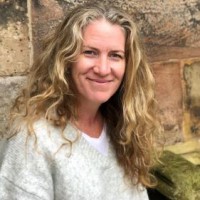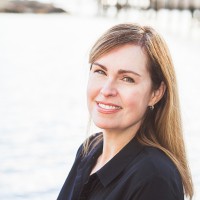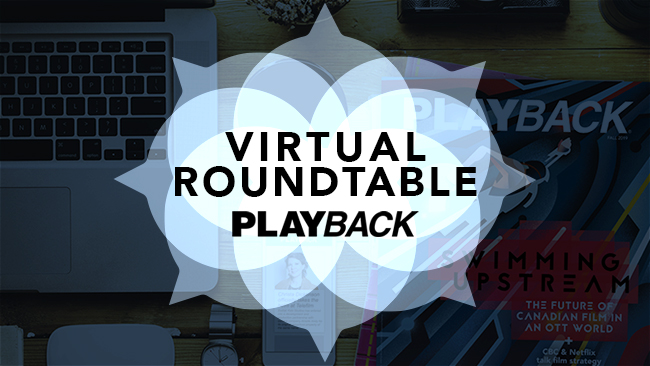Playback’s virtual roundtable pt. 1: producers unpack COVID-19 fallout
With the pandemic upending every facet of the domestic business, production heads discuss the near-term impact, contingency planning, survival, mental health of employees and their bottom lines. (Unlocked)
The COVID-19 pandemic has upended every aspect of the Canadian production industry over the past four weeks, and looks set to do so for months and potentially years to come. Here, in the first of Playback‘s virtual roundtable discussions, producers discuss the near-term business impact of the COVID-19 situation on their businesses, as well as looking ahead to what the rest of the year could hold for the Canadian screen sector.
The participants in the discussion are: Shaftesbury founder, chairman and CEO Christina Jennings; Cameron Pictures co-founder and executive producer Amy Cameron; marblemedia co-CEO and executive producer Mark Bishop; SEVEN24 Films managing partner Tom Cox; and Thunderbird Entertainment CEO Jennifer Twiner McCarron.
Check Playback Daily tomorrow for the second part of the discussion.
Could you talk about the immediate impact of the production shutdown on your business?
 Christina Jennings: We had to shut down one major production, Departure, which was four weeks away from going to camera, and two small digital productions that were about to go [into production] as well. And then we also have three shows going into prep in April: Murdoch Mysteries, Frankie Drake Mysteries and Hudson & Rex.
Christina Jennings: We had to shut down one major production, Departure, which was four weeks away from going to camera, and two small digital productions that were about to go [into production] as well. And then we also have three shows going into prep in April: Murdoch Mysteries, Frankie Drake Mysteries and Hudson & Rex.
The reality is that all the story departments, all the writers, are continuing to write. The decision we took was to push everything by 90 days. What does that do to deliveries to broadcasters? Because that was the other thing: trying to figure out when we are going to be able to deliver any of these shows to our broadcasters, who need content of course. We’re working right now under the [assumption] that there isn’t an all clear until mid-June and after that we can start prep and start figuring out how to shoot our shows. We’re all in it together and we all want to get going as fast as we can and to deliver [shows] to our broadcasters and our distributors – that’s our reality.
Amy Cameron: We were supposed to start prep on Lady Dicks on Tuesday, March 17. On Thursday of the week before, we were on a call with CBC and NBCUniversal to say “this isn’t looking great,” so we’re going to do a slow burn prep, which meant that we were really trying to contain the number of people we were bringing in for prep on the following Tuesday. But by Monday, we knew we had to pull that. Since then we’ve been making decisions on a daily basis. We, too, are planning for a potential June start and I feel like that would be our best-case scenario at this point. I’m sending out emails to our crew every week to tell them where we’re at. We’re also holding the studio [space] for three months, so that we can jump right in, should we be so lucky.
The writers continue to write – that’s the one area we have some control over and are trying to focus on. So that, once we get to shooting, if we have all 10 episodes written, we’ll be in a situation where we can find some efficiencies to help mitigate the cost.
 Mark Bishop: We were incredibly blessed that we had two big unscripted series – one that wrapped on the Wednesday and one that wrapped on the Thursday, just before the shutdown on the Friday. One is a second season of our show All-Round Champion, the other is a second season of Blown Away. Both of them have elimination, competition and they have weather dependencies that… I don’t know what we would have done if we had been unable to get those shows in the can.
Mark Bishop: We were incredibly blessed that we had two big unscripted series – one that wrapped on the Wednesday and one that wrapped on the Thursday, just before the shutdown on the Friday. One is a second season of our show All-Round Champion, the other is a second season of Blown Away. Both of them have elimination, competition and they have weather dependencies that… I don’t know what we would have done if we had been unable to get those shows in the can.
We have quickly transitioned to post and ramped up faster to put all these systems [into place]. Over the past six months we’ve put in new video servers for shared access, expanded a number of editing suites, switched over to the Microsoft Teams platform and put in an IP-based phone system. Our IT department had been working to roll out all these things, and then very quickly that weekend [March 14, 15] it was like “OK, now we’re going to test them all.”
We had 14 edit suites going by Monday afternoon [March 16], which are all remote so everyone can work from home and access our file servers. We still have one colorist who goes into the office, and that’s it. Everything else is done completely remotely.
For us, right now, it’s a lot of contingency planning for what happens next. We had a greenlight on a Christmas short-run series for one of the big SVODs in the U.S that was slated to go to camera in May. Now, of course, that’s back-burnered. That’s one that [could be challenging] because we have U.S. talent coming in and we have a tight window to make the holiday season. We also have a summer, outdoor series that is greenlit and scheduled to go to camera this summer, but it needs to capitalize on that summer weather.
With both of those projects, we’re doing these massive “ABC” risk-mitigation plans. [We’re asking ourselves] how much can we start prepping? And what’s our drop date [for making calls on projects]? They have these really complex matrix grids of what will happen at a certain date. At this point, we’re talking about June as being our best-case scenario, but what happens if it’s later? And at what point do those shows hit the point where they’re no longer viable?
So we’re having almost daily calls with our partners. With the American partners, the situation is different there and in certain cities, obviously, it’s even more dire than it is here. I think there’s a lot of fear, there’s a lot of mis-information out there. All we can do is explain what is happening here to the best of our ability, and to have as many backup and contingency plans in place [as possible].
Obviously we never want to go back to work at a time when it’s not safe, but we don’t know exactly when that will be or what will going to look like, [so we’re] putting in a lot of different plans for if we have to start prep and even pre-production on a scaled-back, reduced or at-home capacity.
 Tom Cox: We had two big-budget dramas in active production – one was halfway through its current season and the other was just in the midst of its first block of shooting. We have another show that was beginning prep that was due to begin shooting in late April. Among the three, there are probably 450 cast and crew affected.
Tom Cox: We had two big-budget dramas in active production – one was halfway through its current season and the other was just in the midst of its first block of shooting. We have another show that was beginning prep that was due to begin shooting in late April. Among the three, there are probably 450 cast and crew affected.
We’re trying to keep the writing departments going and, to the degree that we can, we will complete scripts on possibly all the shows before we’re able to get back into production, which is a bit of a silver lining. At the same time, we’re working with the broadcasters to determine contingency plans for delivery and broadcast.
We have another show that is slated to begin production in August, so our hope is to keep the current production schedule intact. On the two shows that were in production, we are trying to continue with post – a bit of editing, though we won’t be able to do a lot of mixing and completion. But we’ll get as far as we can in that process to ensure we’re delivering some episodes to the broadcasters and distributors that they can at least use to promote the show.
Jennifer Twiner McCarron: [On the scripted side] Kim’s Convenience is in a writing cycle, so we’re pushing back the start of production to whenever we can actually start shooting. Our factual division, Great Pacific Media, was luckily at the end of most of the shooting cycles, so we’re going into heavy post-production on all of the factual shows such as Highway Thru Hell. There were a couple of factual shows we had to stop shooting slightly earlier on. So, for example, if we were supposed to deliver 18 episodes, [now we’re looking at whether we] deliver 16 episodes or perhaps 18 slightly thinner episodes.
Of our 1,000 employees, 700-plus are in animation, which something that can continue off site. Shortly after Kidscreen Summit [in January], the IT and pipeline teams came to see me and said: “We’re watching what’s going on in Asia and we’re concerned we [might need to] work from home.” So, as a company, we were able to order a firewall and get set up with Teradici, which is a secured work-from-home software that [remotely] ports you into your [work] computer. As of last March 27, we have safely secured all 700-plus animation employees off site.
With animation in particular, there’s an increased focus there because people need content and animation is something that, regardless of the timelines, can continue to be produced. We’re not declaring victory yet, of course. We’re all off site and it’s working well thus far, but now our focus is on optimizing people’s work home stations and work flows to continue to allow those deliveries to happen.
If this does go beyond June, how big of an issue will it be for the production community?
Jennings: As companies, all of us rely on delivering shows to make our financial results. In our industry, you recognize your revenue as a company when you’ve delivered all the shows. If it’s pushed back too much, it’s going to have some implications to all our bottom lines. It just is – that’s what’s going to happen. If we can get going this summer, many of us will come out this, I’d say, OK. If it goes a lot longer into the fall and, god forbid, into the top of next year, I think there are going to be some real challenges for a lot of us.
Bishop: Especially for projects that are seasonally dependent, there’s a risk that certain shows get cancelled altogether or get punted.
If it does go later than June, for example on our [summer, outdoor] kids scripted series, we may do the studio portion this fall and then wait until next spring to do the outdoor [portion of the filming]. But, again, it’s very difficult and I do worry that some of the shows will be delayed from a revenue-recognition and broadcaster-delivery point, or that some will just end up getting cancelled if they’re not viable.
Cox: All of us probably have interim financing on our shows, which obviously continues to stack up – and the longer we go, the more interest we incur, and the later the tax credits are. All of those things that have been mentioned will definitely have an impact on the bottom line and will eventually have an impact on whether we’re able to keep our own corporate employees going.
The small saving grace of working mainly in Calgary is that we get four seasons in one day, and most of our shows are pretty resilient when it comes to weathering the climate. But it’s the ongoing costs and the degree to which broadcasters are able to honor their own broadcast schedules, and that we’re able to honor our delivery schedules.
 Cameron: There’s an added complication given that so many of the studios, at least in Toronto, are booked solid, which is why we’re holding onto ours. But, beyond holding it for three months, it becomes a balance of “is this fiscally responsible to hold onto this studio space for any longer?”
Cameron: There’s an added complication given that so many of the studios, at least in Toronto, are booked solid, which is why we’re holding onto ours. But, beyond holding it for three months, it becomes a balance of “is this fiscally responsible to hold onto this studio space for any longer?”
Other production companies that I’ve been talking to in Toronto have been looking at getting into their studios – doing a smaller shoot and trying to get all the studio shooting done – so that we can then go out onto location, because the reality, too, is that convincing people to let you go onto their location with a massive crew is going to be a completely different kind of conversation post-COVID-19.
Cox: We’re holding three studios currently – two in Calgary and one in Vancouver. For the same reason as Amy, we can’t give anything up or we have no guarantee of getting it back. So for at least the next three months, we are holding our spaces.
But, to Amy’s point, the conversation will turn to: what kind of world are we heading into? And will we ever have the same kind of unfettered access to public spaces and large numbers of people gathering for production that we’ve enjoyed in the past. It’s a serious question for us all.
For Atomic Cartoons, to what degree is it insulated from this situation? And what do work-from-home protocols mean for your animation business?
 Twiner McCarron: You don’t need 250 people together on set to make content and that’s simply the bottom line. It’s something that people can do in isolation. I think the animation industry will see a resettling, where more of our groups will probably stay at home.
Twiner McCarron: You don’t need 250 people together on set to make content and that’s simply the bottom line. It’s something that people can do in isolation. I think the animation industry will see a resettling, where more of our groups will probably stay at home.
We’ve talked about working from home for years and a lot of artists have requested it. We never would’ve tried to get 800 people off site at once, had it not been our new world order – and now we’re seeing some positives. We’ll look at departments that maybe work better from home. For design and storyboard, as long as we’re having those weekly meetings, there’s efficiencies to be gained. For example, people are getting back their commuting times. And maybe it’ll be better for the environment in different ways.
In terms of all the big conferences that we attend, flying to France two or three times a year to meet with people largely from North America, maybe those things will cease to happen a little bit and maybe that’s OK. In animation, the intangible, magic stuff happens [when you get] different energies in rooms and brainstorm. How does that work remotely?
I’m also really focusing on: how’s the mental health of everyone working remotely? That hasn’t played out yet. As a company, we’re trying to focus on taking care of our employees and their mental health and being aware of people having unique circumstances. A lot of people have kids. Others are alone – have recently moved to Vancouver for a job and don’t have a lot of resources around them, and now they’re sitting basically alone in an apartment and we’ve given them a bunch of equipment and a Teradici licence and said “OK go.” How does that look? We’re really in the early days of assessing that and trying to support everyone through that.
It’s true, we can continue delivering [shows], but what remains to be seen is the intangibles – how that affects productivity, and the care that we have for people in their unique situations.
Keep up with Playback‘s ongoing coverage of COVID-19 here.


 The definitive CDN broadcast and production resource.
The definitive CDN broadcast and production resource.










